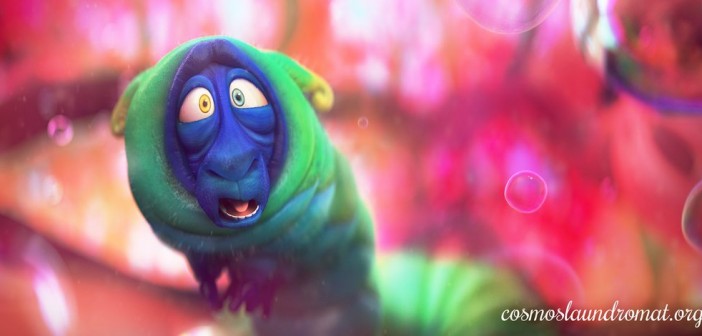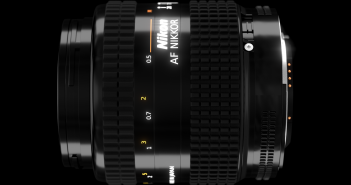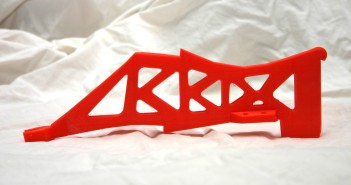This is an image you'll be seeing a LOT during the next months - the new splash screen for Blender 2.75. Taken from Gooseberry, it's a wonderfully psychedelic and vibrant scene. I'm going to enjoy it, and you? (Click to enlarge)
Advertisement
You're blocking ads, which pay for BlenderNation. Read about other ways to support us.
About the Author
Bart Veldhuizen
I have a LONG history with Blender - I wrote some of the earliest Blender tutorials, worked for Not a Number and helped run the crowdfunding campaign that open sourced Blender (the first one on the internet!). I founded BlenderNation in 2006 and have been editing it every single day since then ;-) I also run the Blender Artists forum and I'm Head of Community at Sketchfab.




29 Comments
Is that a catersheeper? (caterpillar and sheep)
Or a Sheeperpillar?
Love it! Brilliant, beautiful, excellent. Great job!
AMAZING!! I LOVE BLENDER, I LOVE ART! PLEASE ARTISTS AND DEVELOPERS, WE CAN MAKE MUCH FOR BLENDER!!!
The face looks like emerging from a vagina, you cannot unsee it when you see it :)
I HOPE YOU KNOW WHAT YOU'VE DONE
Hahaha!
In this case I would expect that the pupils should be more dilated.
This one goes in to the top 10 of the craziest comments I've ever seen here on BlenderNation ;-)
i was just thinking about that, but hesitated to say it.
.
.
.
thanks :D
You horrible person.
Worse, it's clearly a green dick that has a vagina on top!
What sick individual would make this?
Oh... no... You really cannot unsee that.
Very except for the font of the small text, put something more niiiiiice
Nice, I want to see the movie rendered through in new realtime engine :D
then you can do some realtime mocap A la avatar, and finish this thing in a few months, rather then years :D
Kgo.
I don't want that thing with that facial impression to look at me during Blender startup. Guess i'll turn off splash screen in 2.75
I tend to agree, it is funny also as noted! Can we instead have him looking from the cliff, as a metaphor for the user gazing into blender's vast possibilities?
Oh dear. That sort of creature appeared in A Bug's Life / Antz in 1998. Shouldn't Blender have a splash screen that demonstrates how *current* it is?
In a few years Blender will be "Industry Standard"!
Why?
Because of the crazy license politics of the big software companies to force their customers to "rent" rather to buy the software. And Blender is free of this craziness ... well it is developed by crazy people, but crazy in a positive sense ...
"In a few years Blender will be 'Industry Standard'"!
Not a chance. I like Blender, often prefer it for polygonal modeling over other software, and support its effort. But it's just plain delusional to claim that in just a few years, it'll become industry standard.
1. While I'm no fan of subscriptions myself, the common misconception is that you're "renting" the programs. For most subscription-based services, you're not renting, as much as you're paying for continued service.
You can just pay for a month of the software and continue to use whatever version of software you've managed to download during that paid month. You can continue to use the software--you just won't get the updates--you're not forced to upgrade.
2. The subscription-based service isn't as greedy as you'd think.
http://www.cnet.com/news/how-greedy-is-adobes-creative-cloud-subscription-not-very/
Rather than suffer losses to piracy, which is a growing problem not with just individuals but with industry companies as well, they'd rather make some of their money back by offering affordability than lose all of it to people not wanting to pay multiple thousands up-front.
It's similar to what the music industry's doing with subscription-based music services--they'd rather appeal to some money made than none made at all. I think people truly underestimate what effect piracy has had in driving these companies to rather desperate strategies.
Personally, I don't blame them. Developers have to eat and pay bills, too. It takes a whole company to offer an industry-standard (even if several have grown complacent). They have the right to free enterprise, and the same people complaining about their lower-cost monthly subscriptions are often the same ones who pirated Photoshop back when people were complaining about its premium price.
3. Largely, it's the non-professional portion (the "fans," rather than the hardcore productive users) among the community look at Blender's free and open-source nature as the strongest reason for its rise.
People in the industry don't need free and open-source as much as they need reliable and keeping with cutting-edge. They'd rather pay for efficiency than merely go with an inefficient cheaper option. Time is more valuable to industry than money.
Blender FANS are failing to realize that nobody's really adopting Blender, much beyond individual freelancers and small studios (typically made of such freelancers). They see news of Blender's minor use in Spider-Man 2 for its mere animatics, and suddenly Blenderheads celebrate,
No major company's really incorporated Blender into their pipeline in any significant way. There's a reason for it--and it's not just industry mere elitism against Blender. Blender (and its community) is a hermetic among software.
Blender doesn't play well with other software, like between ZBrush and MARI, which BOTH support Maya/Max and MODO files natively respectively. Many in the community throw stones at Chaos Group for offering a commercial V-Ray plugin for Blender.
Blender's often late to the party of some emerging new standards, like how it's just now adding PTEX, while others are adopting geodesic voxel binding and PBR-ready pipelines.
Nobody wants to support native Blend files in their third-party software, because of conflicts with its liberal GPL license as well as its very frequent nature of updates (system changes).
Blender is very slow in adopting and improving standards like FBX and Alembic--which we needed several years ago, not late into 2015.
Blender tries to focus on so many areas at once, that nothing gets polished. I mean, NOTHING about Blender feels unified--none of the Modes work together yet.
And Blender's rapidly approaching a problem that should've been solved a decade ago: An overcrowded user interface (first introduced in 2.5x as a "temporary" solution, if you remember), that's now become like the overstuffed closet that developers are afraid to open and clean. It's an ad-hoc result that people generally panic whenever we mention "redesign."
This isn't at all to knock what progress we HAVE seen of Blender and its generous developers. Blender's a great effort. It just lacks direction. What Blender needs is to take a page from MODO's developers. MODO's developers take their time together, to work on a release in a coordinated fashion, to ensure unity in developer vision and cohesion with development.
Nothing feels scattered, tacked on or superfluous in MODO, because a lot of thought and effort went into careful, focused direction. They don't release a million releases a year--they release one big release with a few package updates. They go about development in a very thoughtful way.
Blender needs that so badly. Instead of using films like Gooseberry to work on new features, they need to work on fixing old ones. It needs developers to pick a theme/direction for development and finish that aspect of Blender until its well-polished and well-integrated.
But alas, it seems that the bulk of Blender development goes in favor of shinier simulation features or camera-tracking tools--which are nice, but not top-priority. Too many important improvements get pushed back to Blender developers adding more stuff to Blender before completing existing features.
And thus, a large par of the reason nobody wants to touch Blender in the industry. Blender has a long way to go before ever becoming "standard." People will pay for proficient tools, even while a free option like Blender's available.
For instance, I use Maya LT to do my game development work with Unreal Engine 4. I simply couldn't wait around last year for the FBX support Blender started to address this year. But there are far more area that need to be focused by developers together and polished enough to let me work with other software easier. Blender doesn't do this yet, and at the rate its going, stubbornly against necessary changes, it'll be far more than "a few years" before Blender becomes an industry standard.
All you said is super true, cannot agree more. I'll just add some more analysis:
Ton want's to make movies now, Blender is just a tool for him and what will do the job will be enough - there's no need for cutting edge stuff in Blender it seems.
If he wanted to really develop Blender there could be a fundraising for specific features that people would support, developers could be hired and stuff being done. We rather got kick-starter for his film.
Blender attracts noobs and there is way too many things in the software to learn already. What they focus now is making tutorials and resources for such newbies and that gives them the most money.
And now commercial software is getting cheaper and affordable. I hope more people will realize that free doesn't mean that they will save money. Time and nerves are expensive.
True, true. I am one of the noobs that came to blender, and now that I look deeper into it, Blender is developing useless shinies rather than necessary things many people actually need. We don't need Stereo3d stuff and blah blah blah(though it is cool), we need stuff that will actually help us in other walks of life, like FBX, proper meshes(for game engines), industry standards, etc. etc. The developers have done a great job, but a lot of stuff feels incomplete and runs into bugs. Though its fine for my uses right now :)
Nice..:)
The original splash color was so bad.
1. High saturation between complementary color pair (causing discomfort)
2. Value range too wide hence contrast too high
3. All part of the image screams for attention (because of #1)
https://plus.google.com/u/0/+LightBWK/posts/eNXLRHZe4QQ
The fix: http://www.pasteall.org/pic/show.php?id=89302
I suggest the splash image to be color graded before final release.
In the tradition of stating a personal aesthetic opinion as if it's a fact...
Your "fix" is simply not.
It's not opinion, you can measure it.
Just color pick from the original image.
Here is the amount of saturation of the original image.
http://pasteall.org/pic/show.php?id=89303
Almost all of the image is saturated white
Here is the hue, my node setup is used to find possible extreme complementary pair next to each other on the image. The split HSVA node only shows hue in greyscale, I put hue back so that we can actually see it.
http://pasteall.org/pic/show.php?id=89304
The common rule is to never put high saturation colors which are complementary side by side. If you still wanted to do so, lower saturation on either one of the color pair. But on the original image, everything is saturated. Leaving no mercy for our eyes.
For value, it is quite OK (even though it got edited on my enhance pass). The high contrast is mostly caused by hue (complementary pairs) and high saturation all over the image.
Color is part of composition and this composition failed the color department with measurable proof.
Ton just posted this on Twitter:
https://twitter.com/tonroosendaal/status/608946912088190976
Saw it before previous post was posted here. :)
I see that you focused the viewer to Franck's face, but the image lost some of its "hot ambiance" effect, it's like a bit colder (even tough it's still mostly on the hot colors side), and Franck has a more sick color to his face, especially on the nose.